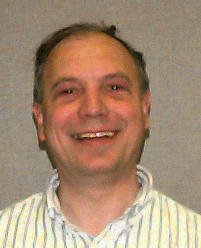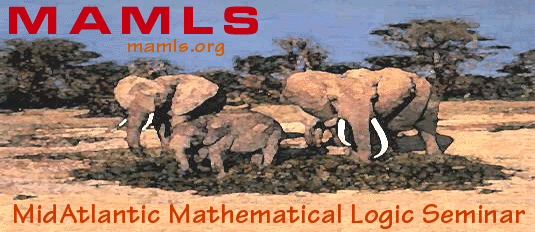|
|
|
SCIENTIFIC PROGRAMS AND ACTIVITIES |
|||||||||||||||||||||||||||||||||||||||||||||||||||||||||||||||||||||||||||||||||||||||||||||||||||||||||||||||||||||||||||||||||||||||||||||||||||||||||||||
| April 29, 2024 |
|
||||||||||||||||||||||||||||||||||||||||||||||||||||||||||||||||||||||||||||||||||||||||||||||||||||||||||||||||||||||||||||||||||||||||||||||||||||||||||||||
This two day conference is in honour of the 60th anniversary of
Professor Andreas R. Blass, from the Department of Mathematics at
the University of Michigan. Schedule
Tomek Bartoszynski, Boise State University In 1919 Borel attempted to characterize all measure zero sets with respect to their open covers. In particular he came across a notion that he called a strong measure zero - a set of reals X is of strong measure zero if for every sequence epsilon_n there are open sets U_n of diameter epsilon_n whose union covers X. Borel conjectured that the only strong measure zero sets are countable sets, and as Laver showed in 1976 this was not without merit. Today the Borel Conjecture is a prototype of a characterization of countable/uncountable using topological or metric terms. In this talk I will survey the Borel Conjecture and related statements and their current status. Alan Dow, University of North Carolina We discuss recent applications of forcing and the Proper Forcing Axiom to the study mappings and images of the Stone-Cech remainder of the real line and of the integers. Todd Eisworth, Ohio University We will some new (and old) results outlining the connections between
club-guessing and coloring theorems proved using minimal walks.
We will concentrate on successors of singular cardinals, but ``small''
large cardinals might very well make an appearance as well. Rüdiger Göebel, Universität
Duisburg-Essen Andreas Blass exhibited in several papers very interesting properties
of subgroups of the Baer-Specker group, the group of all integer
valued functions. Theorem: For a fixed integer $m \geq 2$, we construct a slender reflexive group $G$ such that for all positive integers $n$, $G \cong G \oplus \Z ^n$ if and only if $m$ divides $n$. Without the restriction to reflexive groups, this result was obtained by Eklof and Shelah, answering a problem by Gabriel Sabbagh (see P. Eklof, S. Shelah, `On groups $A$ such that $A\oplus \Z^n \cong A$?, Abelian group theory (Oberwolfach, 1985)(1987) 149--163). The case - "m=2 (one implication)" also assuming Martin's axiom and reflexivity - was considered in R. G\"obel, S. Shelah (Reflexive subgroups of the Baer-Specker group and Martin's axiom, Proc. Perth Conference (2001) 145--158.) Answering a problem in the book by P. Eklof, A. Mekler (Almost
free modules, Set-theoretic methods, North-Holland, Amsterdam 1990.)
we constructed at that time such reflexive groups $G$ with $G\oplus
\Z \not\cong G$. Thus our new theorem unifies and strengthens both
of these results. It remains a challenging open problem if Martin's
axiom can be removed! Yuri Gurevich, Microsoft Research
The fraction of n-vertex graphs that are connected, that is the
probability that an n-vertex graph is connected when all n-vertex
graphs have the same probability, grows to 1 as n grows to infinity.
In that sense almost all finite graphs are connected. Similarly
almost all graphs are Hamiltonian, not 3-colorable, rigid, etc.
Is there a general phenomenon behind results of that sort? It turns
out that much depends on the logical form of the property in question.
In particular, every first-order sentence in purely relational vocabulary
is almost surely true or almost surely false on finite structures.
This zero-one law for first-order logic was generalized in various
directions: richer logics, non-uniform probability distributions,
special classes of structures, etc. We will explain some of the
results including a geometric zero-one law of Bob Gilman, Alexei
Miasnikov and the speaker. Neil Hindman, Howard University Furstenberg's original {\em Central Sets Theorem\/} applied to {\em central\/} subsets of $\mathbb N$ and finitely many specified sequences in $\mathbb Z$. In this form it was already strong enough to derive some very strong combinatorial consequences, such as the fact that a central subset of $\mathbb N$ contains solutions to all partition regular systems of homogeneous equations. Subsequently the Central Sets Theorem was extended to apply to arbitrary semigroups and countably many specified sequences. In this paper we derive a new version of the Central Sets Theorem for arbitrary semigroups $S$ which applies to {\em all\/} sequences in $S$ at once. We show that the new version is strictly stronger than the original version applied to the semigroup $(\mathbb R,+)$. And we show that the noncommutative versions are strictly increasing in strength. Bart Kastermans, University of Wisconsin-Madison We will explain a question on generating sets for cofinitary groups, and give an outline of an approximation to the answer: Cofinitary groups are subgroups of the symmetric group on the natural
numbers where all nonidentity elements have only finitely many fixed
points. Towards answering the question of their possible complexities
there are two results on the upper bounds. The question is whether
these are actually different. We'll give an approximation to the
answer that is of recursion theoretic nature. Arnold W. Miller, University of Wisconsin-Madison How is the axiom of choice used in the set theory of the real
line? I will describe a result concerning the hierarchy of Borel
sets in a model of set theory in which the axiom of choice fails
very badly. Recall that a set of reals is Borel if it is in the
smallest family of sets containing the open sets and closed under
countable unions and complements. Bruce Sagan, Michigan State University A permutation $\pi=a_1a_2\ldots a_n$ in the symmetric group $S_n$ has an {\it increasing subsequence of length $m$\/} if there are indices $i_1<i_2<\ldots<i_m$ such that $a_{i_1}<a_{i_2}<\ldots<a_{i_m}$. Decreasing subsequences are defined similarly. A famous theorem of Erd\H{o}s and Szekeres states that any permutation in S_{mn+1}$ has either an increasing subsequence of length $m+1$ or a decreasing subsequence of length $n+1$. In a monotonic sequence game, two players form a sequence by alternately choosing distinct elements from the set $\{1,2,\ldots,mn+1\}$. The game ends when the resulting sequence contains either an increasing subsequence of length $m+1$ or a decreasing one of length $n+1$. By the Erd\H{o}s-Szekeres Theorem, this must happen at some point. Harary, Sagan, and West were the first ones to investigate this game and determine who wins when either $m$ or $n$ is sufficiently small. We investigate the behaviour of this game when played by choosing elements from other partially ordered sets. In particular, using rational numbers yields interesting results via a variant of the Robinson-Schensted-Knuth correspondence. Andre Scedrov, University of Pennsylvania The design and security analysis of protocols that use cryptographic
primitives is one of the most fundamental and challenging areas
of computer security research. Relatively succinct but subtle authentication,
key exchange, negotiation, authorization, and related protocols
are the building blocks for secure distributed systems. Protocol
analysis is a successful scientific area with two important but
historically independent foundations, one based on symbolic computation
and one based on computational complexity theory. Here we highlight
joint work with Cervesato, Jaggard, Tsay, and Walstad on the formal
analysis of the Kerberos 5 authentication protocol suite. This work
Gary Weiss, University of Cincinnati Participant List as of November 10, 2007
Mailing List : To receive updates on activities at Fields please subscribe to our mailing list at www.fields.utoronto.ca/maillist
|
|||||||||||||||||||||||||||||||||||||||||||||||||||||||||||||||||||||||||||||||||||||||||||||||||||||||||||||||||||||||||||||||||||||||||||||||||||||||||||||||



